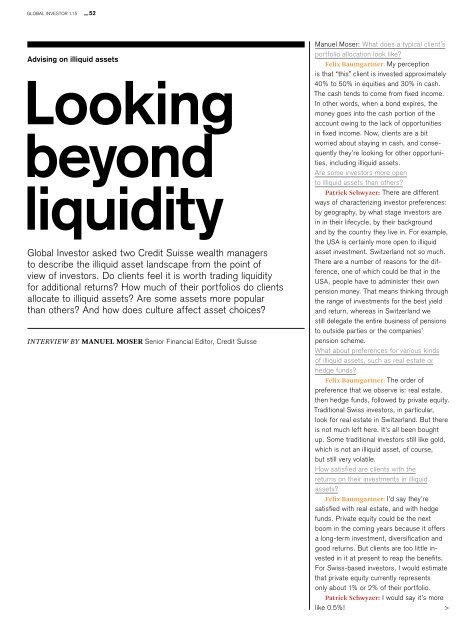Illiquid assets
Unwrapping alternative returns Global Investor, 01/2015 Credit Suisse
Unwrapping alternative returns
Global Investor, 01/2015
Credit Suisse
You also want an ePaper? Increase the reach of your titles
YUMPU automatically turns print PDFs into web optimized ePapers that Google loves.
GLOBAL INVESTOR 1.15 — 52 ><br />
Advising on illiquid <strong>assets</strong><br />
Looking<br />
beyond<br />
liquidity<br />
Global Investor asked two Credit Suisse wealth managers<br />
to describe the illiquid asset landscape from the point of<br />
view of investors. Do clients feel it is worth trading liquidity<br />
for additional returns? How much of their portfolios do clients<br />
allocate to illiquid <strong>assets</strong>? Are some <strong>assets</strong> more popular<br />
than others? And how does culture affect asset choices?<br />
INTERVIEW BY MANUEL MOSER Senior Financial Editor, Credit Suisse<br />
Manuel Moser: What does a typical client’s<br />
portfolio allocation look like?<br />
Felix Baumgartner: My perception<br />
is that “this” client is invested approximately<br />
40% to 50% in equities and 30% in cash.<br />
The cash tends to come from fixed income.<br />
In other words, when a bond expires, the<br />
money goes into the cash portion of the<br />
account owing to the lack of opportunities<br />
in fixed income. Now, clients are a bit<br />
worried about staying in cash, and consequently<br />
they’re looking for other opportunities,<br />
including illiquid <strong>assets</strong>.<br />
Are some investors more open<br />
to illiquid <strong>assets</strong> than others?<br />
Patrick Schwyzer: There are different<br />
ways of characterizing investor preferences:<br />
by geography, by what stage investors are<br />
in in their lifecycle, by their background<br />
and by the country they live in. For example,<br />
the USA is certainly more open to illiquid<br />
asset investment. Switzerland not so much.<br />
There are a number of reasons for the difference,<br />
one of which could be that in the<br />
USA, people have to administer their own<br />
pension money. That means thinking through<br />
the range of investments for the best yield<br />
and return, whereas in Switzerland we<br />
still delegate the entire business of pensions<br />
to outside parties or the companies’<br />
pension scheme.<br />
What about preferences for various kinds<br />
of illiquid <strong>assets</strong>, such as real estate or<br />
hedge funds?<br />
Felix Baumgartner: The order of<br />
pre ference that we observe is: real estate,<br />
then hedge funds, followed by private equity.<br />
Traditional Swiss investors, in particular,<br />
look for real estate in Switzerland. But there<br />
is not much left here. It’s all been bought<br />
up. Some traditional investors still like gold,<br />
which is not an illiquid asset, of course,<br />
but still very volatile.<br />
How satisfied are clients with the<br />
returns on their investments in illiquid<br />
<strong>assets</strong>?<br />
Felix Baumgartner: I’d say they’re<br />
satisfied with real estate, and with hedge<br />
funds. Private equity could be the next<br />
boom in the coming years because it offers<br />
a long-term investment, diversification and<br />
good returns. But clients are too little invested<br />
in it at present to reap the benefits.<br />
For Swiss-based investors, I would estimate<br />
that private equity currently represents<br />
only about 1% or 2% of their portfolio.<br />
Patrick Schwyzer: I would say it’s more<br />
like 0.5%!

















